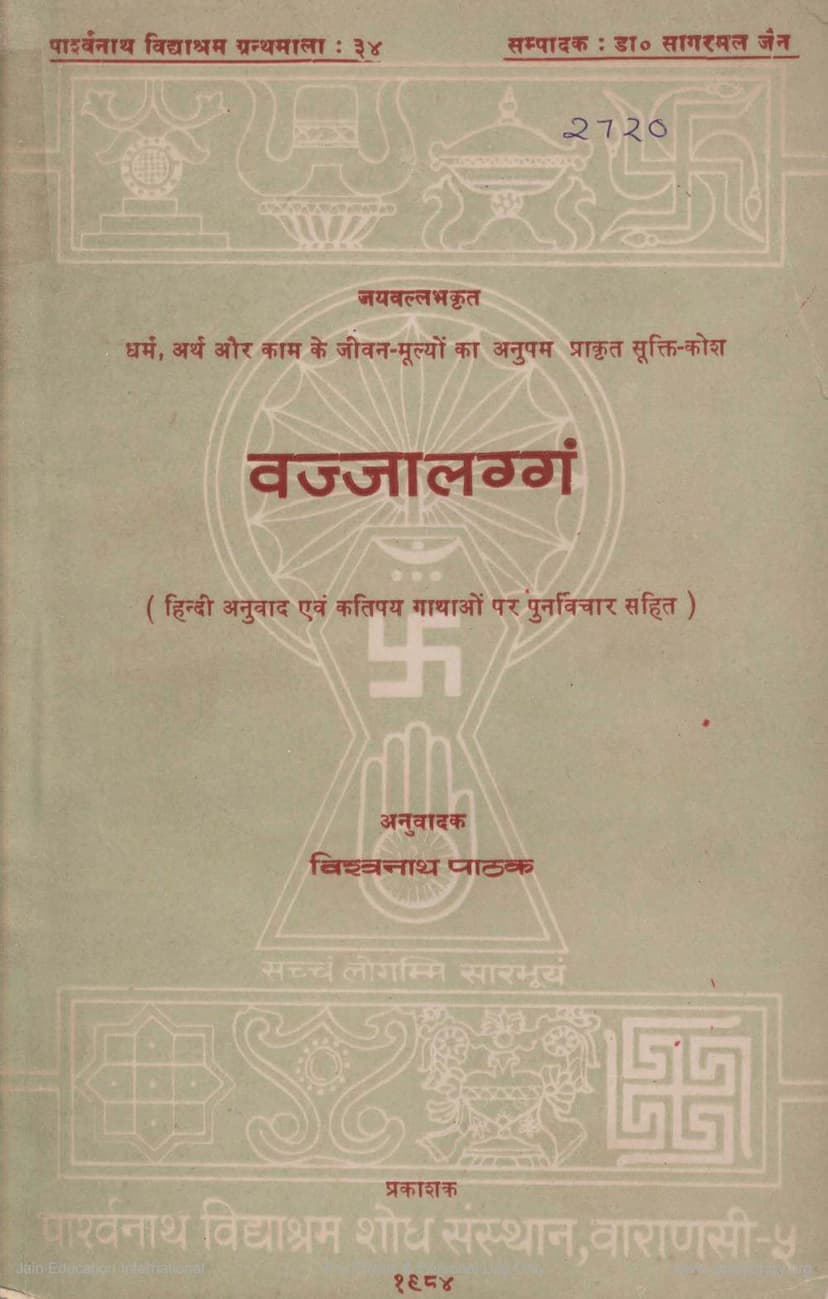Vajjalaggam
Added to library: September 2, 2025

Summary
Here is a comprehensive summary of the Jain text "Vajjalaggam" by Jayavallabh, with a Hindi translation and explanation by Vishwanath Pathak, published by Parshvanath Vidyapith in 1984:
Book Title: Vajjalaggam (with Hindi Translation and Explanation) Author: Jayavallabh Translator and Explainer: Vishwanath Pathak Publisher: Parshvanath Vidyapith Research Institute, Varanasi Year of Publication: 1984
Overview:
Vajjalaggam is a significant collection of Prakrit verses, considered a major work in the tradition of Prakrit subhashita (wise sayings or maxims) literature. Compiled by the Jain monk Jayavallabh, the text is a treasury of aphor isms and verses covering the spectrum of human life, primarily focusing on the goals of Dharma (righteousness), Artha (wealth/material prosperity), and Kama (desire/love).
Nature of the Work:
The title Vajjalaggam itself is explained as a collection of verses organized according to specific categories or themes, referred to as vajja (Sanskrit: vrajya), meaning "methodology" or "chapter." Jayavallabh himself states in the introductory verses that he compiled Vajjalaggam by selecting the best verses from various poets. Therefore, it is fundamentally a compilation rather than an original composition by Jayavallabh. The work follows a tradition initiated by King Hala's famous Gaha Sattasai (Gatha Saptashati). While Gaha Sattasai is renowned for its depiction of contemporary life and love, Vajjalaggam, though later, holds significant historical and literary value for preserving numerous beautiful but often anonymous verses, showcasing various aspects of life and poetic expressions.
Key Features and Content:
-
Compilation and Authorship: Jayavallabh, a Shvetambara Jain monk and scholar, is credited with compiling this collection. He was proficient in Sanskrit but chose Prakrit to make these valuable sayings accessible to a wider audience, observing people's inclination towards Prakrit and their love for poetry, even amidst a lack of Sanskrit knowledge. The collection includes verses from diverse poets, reflecting a broad range of literary influences.
-
Structure and Themes: The Vajjalaggam is organized into 95 distinct sections, or vajja, each focusing on a specific theme or subject. These themes cover a vast array of human experiences and societal aspects, including:
- Ethical and Moral Teachings (Dharma): Sections like Niti-vajja (Policy/Ethics), Dhir-vajja (Patience/Fortitude), Sahasa-vajja (Courage/Boldness), Dhammiya-vajja (Religious/Righteous Conduct), Sujana-vajja (Good people), and Durjana-vajja (Bad people) offer moral guidance, reflections on virtue, and warnings against vice.
- Material Prosperity and Conduct (Artha): Sections like Artha-vajja (Wealth), Pahu-vajja (Master/Lord), Sevak-vajja (Servant), and Kripiṇa-vajja (Miser) discuss the acquisition, management, and ethics of wealth, as well as social hierarchy and duty.
- Love, Desire, and Human Relationships (Kama): A significant portion of the collection is dedicated to Kama, with sections such as Neha-vajja (Affection), Prema-vajja (Love), Mana-vajja (Pride/Pretense in Love), Pravasita-vajja (Separation from loved one), Viraha-vajja (Separation/Disunion), Ananga-vajja (Cupid/Love-Lust), Purushalapa-vajja (Conversation between lovers), Piyanuraga-vajja (Affection for the beloved), Duti-vajja (Messenger of love), Surata-vajja (Coition/Love-making), Vesa-vajja (Prostitute), and Kuttini-sikha-vajja (Lessons from a procuress) exploring the nuances of love, desire, courtship, separation, and sensuality.
- Nature and Seasons: Descriptions of various aspects of nature and the changing seasons, such as Vasant-vajja (Spring), Grishma-vajja (Summer), Praush-vajja (Rainy Season), Sharad-vajja (Autumn), Hemanta-vajja (Early Winter), and Shishira-vajja (Late Winter) are present, often used metaphorically or as setting for human emotions.
- Life and Society: The collection also touches upon aspects of life like friendship (Mitra-vajja), family life (Sadhariṇī-vajja - Good Housewife), old age (Jara-vajja - Old Age), and even professions and activities (Vaidya-vajja - Doctor, Jyotishika-vajja - Astrologer, Vyadha-vajja - Hunter, Simha-vajja - Lion, Gaja-vajja - Elephant, etc.).
-
Literary Merit: Vajjalaggam is celebrated for its artistic quality. The verses are crafted with elegant language, sophisticated imagery, and skillful use of literary devices such as figures of speech (alankara) like metaphor (rupaka), simile (upama), irony (vakra-ukti), and especially double entendre (shlesha) which is frequently employed. The verses often convey profound meaning through concise and evocative language. The predominant rasa (aesthetic sentiment) is shringara (eroticism/love), but other rasas like karuṇa (pathos), vīra (heroism), and śānta (peacefulness) are also present.
-
Jain Context and Inclusivity: While compiled by a Jain monk, the Vajjalaggam is remarkably inclusive, drawing heavily from Hindu Puranic traditions and references. It features mentions of deities like Shiva, Brahma, Vishnu, Lakshmi, and Radha, as well as events from Hindu mythology. This broad approach reflects Jayavallabh's intention to gather universal wisdom, recognizing that truths about life transcend sectarian boundaries. The Jain elements are subtle, often found in the compiler's introductory prayers and the overall emphasis on ethical living.
-
Hindi Translation and Explanation: The presented edition is particularly valuable for its comprehensive Hindi translation and detailed explanation by Vishwanath Pathak. Pathak's work addresses the ambiguities and obscurities found in earlier editions (like the German and English translations), offering new interpretations and reconsiderations of certain verses, often drawing on linguistic and literary analysis. The translation aims to bring the richness and depth of the Prakrit verses to Hindi readers, making this ancient text accessible.
Significance:
Vajjalaggam is considered a successor to Gaha Sattasai in Prakrit literature. It serves as a rich source for understanding the social, cultural, and ethical values of ancient India. Its compilation preserved valuable poetic expressions that might otherwise have been lost. The work's aesthetic appeal and philosophical insights continue to resonate, offering guidance on living a meaningful life through its profound and timeless wisdom. The Hindi translation and explanation by Vishwanath Pathak make this classical text accessible to a modern Indian audience, bridging the gap between ancient wisdom and contemporary understanding.
In essence, Vajjalaggam is a monumental compilation of Prakrit verses, curated by Jayavallabh, that offers timeless wisdom on Dharma, Artha, and Kama, presented through exquisite poetry. Vishwanath Pathak's translation and scholarly explanation further enhance its accessibility and appreciation for a wider readership.